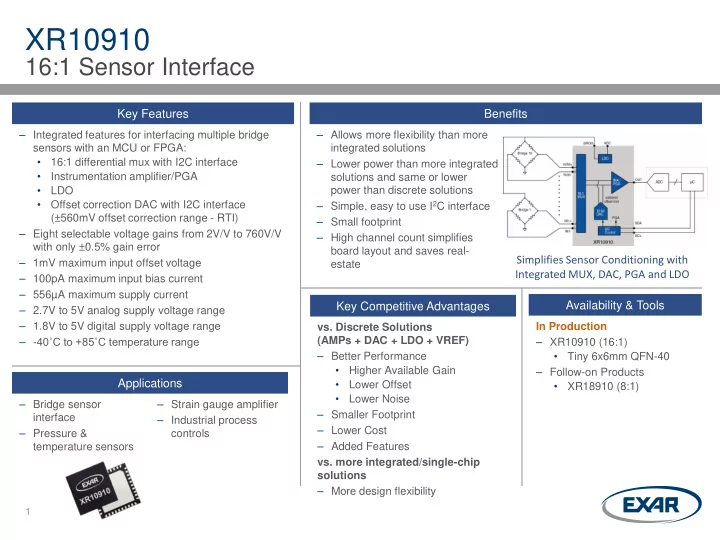

XR10910 16:1 Sensor Interface Key Features Benefits – Integrated features for interfacing multiple bridge – Allows more flexibility than more sensors with an MCU or FPGA: integrated solutions • 16:1 differential mux with I2C interface – Lower power than more integrated • Instrumentation amplifier/PGA solutions and same or lower power than discrete solutions • LDO • Offset correction DAC with I2C interface – Simple, easy to use I 2 C interface (±560mV offset correction range - RTI) – Small footprint – Eight selectable voltage gains from 2V/V to 760V/V – High channel count simplifies with only ±0.5% gain error board layout and saves real- Simplifies Sensor Conditioning with – 1mV maximum input offset voltage estate Integrated MUX, DAC, PGA and LDO – 100pA maximum input bias current – 556µA maximum supply current Availability & Tools Key Competitive Advantages – 2.7V to 5V analog supply voltage range – 1.8V to 5V digital supply voltage range In Production vs. Discrete Solutions – - 40˚C to +85˚C temperature range (AMPs + DAC + LDO + VREF) – XR10910 (16:1) – Better Performance • Tiny 6x6mm QFN-40 • Higher Available Gain – Follow-on Products Applications • Lower Offset • XR18910 (8:1) • Lower Noise – Bridge sensor – Strain gauge amplifier – Smaller Footprint interface – Industrial process – Lower Cost – Pressure & controls temperature sensors – Added Features vs. more integrated/single-chip solutions – More design flexibility 1
XR10910 Block Diagram 2
XR10910 Typical Application 16:1 Bridge Sensor Interface • XR10910 is designed to integrate multiple bridge sensors with a microcontroller or FPGA • Integrated offset correction DAC provides digital calibration of variable offset voltage generated by the bridge sensors • I2C interface provides user with easy controls for input, gain, and LDO voltage selection, as well as offset calibration • Integrated LDO provides regulated voltage (3V or 2.65V) to power the input bridge sensors, unique design allows the LDO current to be monitored 8 fixed gain settings from 2 to 760V/V with only ± 0.5% gain error • 3
XR10910 Ordering Information and Pinout Refer to Product Data Sheet for latest information 6mm x 6mm QFN 4
Recommend
More recommend